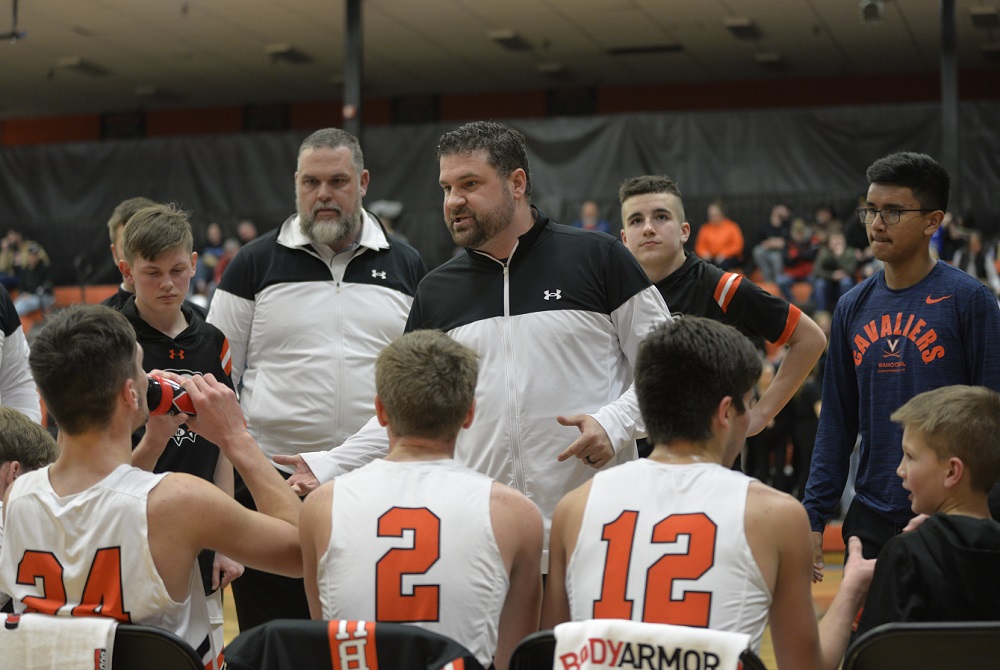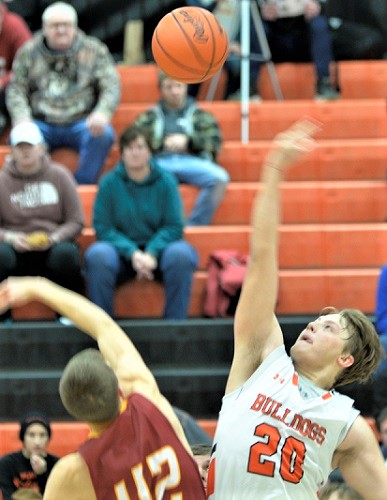
League Change Suiting Mesick Well as Talented Bulldogs Pursue Repeat
By
Tom Spencer
Special for MHSAA.com
January 21, 2022
Who let the dogs out?
 Who, who — let the Mesick Bulldogs — in?
Who, who — let the Mesick Bulldogs — in?
That’s the question West Michigan D League rivals may be asking.
And, it’s more like a what … with the answer being the league’s expansion to 10 schools for the 2018-19 school year that paved the way for Mesick to enter.
Until that point, the Bulldogs were part of the Northwest Conference. They won only three games total over their last two years in the Northwest while competing against schools like Buckley – which reached the Class D championship game in both of the Bulldogs’ final two years in their old league. Mesick’s girls – 8-2 this winter – were struggling too.
The last two years in the Northwest also were the first two for the boys varsity under head coach Kyle Duby. The move may have helped turn things around for Mesick, along with extensive offseason work and youth development efforts.
The Mesick boys won five games in 2018-19 and six in 2019-2020 before going 11-6 last year and capturing a share of the West Michigan D championship – Mesick’s first piece of a conference basketball championship in 39 years.
Today, they Bulldogs are 7-0 and in the driver’s seat in league play. They have wins over league opponents Big Rapids Crossroads, Bear Lake, Brethren, Mason County Eastern, Walkerville and Baldwin.
The boys, with an outright conference championship on their minds, will finish their first run through the league schedule against Marion next week. Marion came into the West Michigan D at the same time as Mesick.
“This year we knew we wanted to win the conference outright,” said Duby, who also serves as the school’s athletic director. “That’s one of our goals.
“We also have a goal to make a run – whatever that may look like – in the postseason,” he continued. “First and foremost, we wanted to win our conference outright.”
 Keeping their starters healthy and able to play has been a challenge for the Bulldogs, but scoring has not. Injuries and COVID-related absences have caused Duby to alter his starting lineup regularly as the Bulldogs are hitting 70 points-plus per game.
Keeping their starters healthy and able to play has been a challenge for the Bulldogs, but scoring has not. Injuries and COVID-related absences have caused Duby to alter his starting lineup regularly as the Bulldogs are hitting 70 points-plus per game.
Senior forward Conner Simmer is the team’s leading scorer, averaging 18. Another senior, Logan Wienclaw, chips in 12 from his center spot, while juniors Carter Simmer and Caleb Linna contribute 11.5 and 10 points per game, respectively.
“We have several kids who have worked hard for several years,” Duby said. “There is no one person you can shut down and expect to beat us.”
The Bulldogs, who also get almost eight points per game from junior Ashton Simerson, rack up 17 assists per games. Three-point shooting is also a strength. The Bulldogs got into the Michigan record books with 15 3-pointers on 32 tries in Thursday’s 73-45 win over Baldwin.
The Baldwin win helped erase memories of a big loss last year. Things are different as Mesick in nearing the halfway point of this home-and-home conference schedule. The Bulldogs have played the majority of their league games on the road and will be playing host a lot while enjoying their ride in the driver’s seat.
“Baldwin was the team that stopped us from an outright conference championship last year,” Duby said. “Winning in Baldwin and getting through the mental hurdle is exciting for us.”
High scoring has been a major contributor to the Bulldogs’ success to date, along with many of the current varsity having played together since middle school – the same time Duby took over the program.
Film study is another significant factor. Based on the review, the Bulldogs prepare to use a variety of presses and half court defenses from their repertoire.
“We have eight different defenses we can play depending on what the film said,” Duby pointed out. “We do what the films tells us.”
“Luckily I have had these boys since they were in sixth and seventh grade, and we played a lot of summer basketball,” he continued. “They are a high-IQ group.”
The road to success started years ago with a meeting Duby held with the parents of today’s Bulldogs.
“I knew the task of getting to this point was going to be a long one,” Duby said. “Right away, we started having them travel.
“We’d take a junior high, JV and varsity team and go down to Muskegon, Grand Rapids, Lansing … Flint and be downstate in summer about four weekends,” he continued. “We would take our whole program together and caravan and play basketball.”
Duby credits the fast start to his coaching staff, which includes Joe Lewis, Derek Linna, Nathan Hall and Jason McCree.
“My JV coach, Joe Lewis, has been with me since day one,” Duby said. “Over the years we’ve absorbed some dads to the staff.”
 Tom Spencer is a longtime MHSAA-registered basketball and soccer official, and former softball and baseball official, and he also has coached in the northern Lower Peninsula area. He previously has written for the Saginaw News, Bay County Sports Page and Midland Daily News. He can be reached at [email protected] with story ideas for Manistee, Wexford, Missaukee, Roscommon, Ogemaw, Iosco, Alcona, Oscoda, Crawford, Kalkaska, Grand Traverse, Benzie, Leelanau, Antrim, Otsego, Montmorency, Alpena, Presque Isle, Cheboygan, Charlevoix and Emmet counties.
Tom Spencer is a longtime MHSAA-registered basketball and soccer official, and former softball and baseball official, and he also has coached in the northern Lower Peninsula area. He previously has written for the Saginaw News, Bay County Sports Page and Midland Daily News. He can be reached at [email protected] with story ideas for Manistee, Wexford, Missaukee, Roscommon, Ogemaw, Iosco, Alcona, Oscoda, Crawford, Kalkaska, Grand Traverse, Benzie, Leelanau, Antrim, Otsego, Montmorency, Alpena, Presque Isle, Cheboygan, Charlevoix and Emmet counties.
PHOTOS (Top) Mesick boys basketball coach Kyle Duby addresses his team during a game this season. (Middle) Logan Wienclaw (20) goes up for a jump ball. (Photos by Daniel Cochrane.)

Data Dig Continues for Hoops Histories
March 7, 2017
By Ron Pesch
Special for Second Half
There is a list – well actually two – that sit, unfinished, among the “1,001 Projects I’d Like to Complete Before I Die.”
I became the caretaker of these lists back when I inherited the title “Historian for the MHSAA” in 1993.
The original lists contained the scores of all MHSAA Quarterfinal, Semifinal and Final round games for the MHSAA boys and girls basketball tournaments since their origin.
From the 1930s into the late 1960s, the MHSAA tournament game-day program was generally nothing more than a single sheet document, containing tournament brackets and team rosters for the qualifiers.
 In 1969, the program saw a redesign by Lansing sports personality Tim Staudt and premiered at the MHSAA Tournament. Sold for 50 cents, it included a list of “Past Michigan State Champions” containing the names of the winning teams and those schools’ basketball coaches for each of the four classes. The publication also included a couple of articles from Dick Kishpaugh, the author of the champions list. Kishpaugh was identified as “Sports Information Director at Kalamazoo College and … perhaps the most knowledgeable historian on Michigan high school basketball.”
In 1969, the program saw a redesign by Lansing sports personality Tim Staudt and premiered at the MHSAA Tournament. Sold for 50 cents, it included a list of “Past Michigan State Champions” containing the names of the winning teams and those schools’ basketball coaches for each of the four classes. The publication also included a couple of articles from Dick Kishpaugh, the author of the champions list. Kishpaugh was identified as “Sports Information Director at Kalamazoo College and … perhaps the most knowledgeable historian on Michigan high school basketball.”
With the start of the Girls Basketball Tournament in 1973, a similar program design was followed.
Those lists were faithfully updated and published in the game-day programs in the same format until the 1987-88 school year, when the souvenir publications were expanded. For the first time, a list containing opponents and final scores of the boys and girls championship games was now available to the general public.
Among the first tasks I chose to approach when I assumed the duties of MHSAA historian was to chase more information.
Since Kishpaugh’s lists had game scores for the three final rounds of the tournament, and names of the championship coaches, I thought I would try to leave my mark. I began chasing down the names of coaches for the runner-up, as well as final win-loss records for both schools. And while I was at it, I decided to see what I could find for teams that made the Quarterfinals and Semifinals.
Hundreds of hours have gone into adding to and maintaining the lists, and much progress has been made. Yet, some 20+ years later, I’m still trying to fill holes in the data.
The Basketball Coaches Association of Michigan helped spread the word, notifying its membership of the project. Web pages were created for both the boys and girls to show teams still missing information.
 The pursuit has led to friendships, and fascinating stories, documents and images. The late Walter Michael, who had attended the MHSAA Finals for more than 60 years, donated a cache of MHSAA tournament programs from the 1940s through the 1960s that filled in the names of many high school coaches. Del Newell, a sports writer from the Kalamazoo Gazette, knocked out most of the Kalamazoo schools early in my search. Bill Khan, then of the Flint Journal sports department, filled in a large number of missing names and records from the Flint area. The recently retired “Son of Swami,” better known as Mick McCabe, contributed by including the win-loss records of the quarterfinalists in his annual tournament prognostication columns for the Detroit Free Press.
The pursuit has led to friendships, and fascinating stories, documents and images. The late Walter Michael, who had attended the MHSAA Finals for more than 60 years, donated a cache of MHSAA tournament programs from the 1940s through the 1960s that filled in the names of many high school coaches. Del Newell, a sports writer from the Kalamazoo Gazette, knocked out most of the Kalamazoo schools early in my search. Bill Khan, then of the Flint Journal sports department, filled in a large number of missing names and records from the Flint area. The recently retired “Son of Swami,” better known as Mick McCabe, contributed by including the win-loss records of the quarterfinalists in his annual tournament prognostication columns for the Detroit Free Press.
Numerous coaches around the state sent e-mails and letters with the names and records for their predecessors. Prep basketball fans and former players sent along offerings. Rob Madsen from Mt. Pleasant became a huge contributor, and sent regular updates to both lists. He focused on some of the state’s smallest schools, including many from the Upper Peninsula.
Leon Westover sent the win-loss record for little Marlette, 1951 Class C runner-up, as well as one of my favorite photos from that golden era of prep sports. Marlette had “waltzed through the Mid-Thumb League and district, regional and quarter-final tournament games,” wrote Fred J. Vincent of the Port Huron Times-Herald. Marlette slipped past Stanton 41-37 to advance to the Class C title game against unbeaten Detroit St. Andrew.
“Just one game too many …,” continued Vincent, writing from East Lansing’s Jenison Field House following the title game. “That just about explains the one-sided beating Marlette absorbed in the state class C high school basketball final here Saturday afternoon. The final score was 52-26. … One of the smallest teams, physically, in the tournament, it seemed that the Raiders were just worn out.”
Yet, that night, the team was celebrated like the hometown heroes they really were.
 Westover’s photo shows the Red Raiders on the night of the Final, gathered at Teale’s Restaurant in Marlette. The clock indicates its 11:30. The owner, George Teale, has opened up his restaurant for the team to cook them steaks in honor of their achievement. Coach Nieland "Tommy" Thompson and his 22-2 squad look happy, ready to celebrate a long season.
Westover’s photo shows the Red Raiders on the night of the Final, gathered at Teale’s Restaurant in Marlette. The clock indicates its 11:30. The owner, George Teale, has opened up his restaurant for the team to cook them steaks in honor of their achievement. Coach Nieland "Tommy" Thompson and his 22-2 squad look happy, ready to celebrate a long season.
At tournament time, these lists help answer media requests that arise.
Question: When was the last time two undefeated teams met for an MHSAA Finals championship?
Answer: 2003-Class A for the girls. Detroit Martin Luther King topped Flint Northern 58-53. 1971-Class C for the boys. Shelby downed Stockbridge 71-57.
Question: What coach had the longest span between championship game appearances?
Answer: Eddie Powers, coach of Detroit Northern, went 34 years between his Class A championship team in 1930 and his runner-up squad in 1964. The mark is asterisked, however, as the Detroit Public School League chose to stop participation in the annual state tournament from 1931 through 1961. Saginaw’s Larry Laeding went 20 years between winning the 1942 Class A championship and his squad’s 1962 Class A title. Maple City Glen Lake coach Don Miller went 19 seasons between the school’s 1977 Class D title and its 1996 runner-up finish, also in Class D.
For the girls, both Mary Cicerone at Bloomfield Hills Marian and Carl Wayer at Ashley went 16 seasons between appearances. While Cicerone’s Marian teams have made seven visits to the Finals and have won six Class A titles, 16 years elapsed between Marian’s 1998 and 2014 Class A championships. Marian then captured a second consecutive title in 2015. Coach Wayer advance two teams to the title game. Ashley finished as runner-up in Class D in 1980 and again in Class D in 1996. The loss in 1996 came in overtime, and was the only defeat for Ashley that season.
Michigan’s high school basketball tournaments are an experience shared, mostly unchanged, since their beginnings. At the end of the regular season, everyone qualifies for the madness. Yet in the end, only four teams finish as champions. The path mimics the magical trail taken by fathers, grandfathers and great grandfathers, mothers and grandmothers. Qualifying for the Quarterfinals is still a huge triumph, as the round brings together only 32 teams from a field of more than 700 boys teams and more than 650 girls teams.
In my eyes, these lists emphasize that remarkable, undiluted achievement. In a world consumed with trophies and the number “1,” perhaps it is time to step back and celebrate this rare journey.
Click for Ron Pesch's data "Needs Lists" for girls basketball and boys basketball.
 Ron Pesch has taken an active role in researching the history of MHSAA events since 1985 and began writing for MHSAA Finals programs in 1986, adding additional features and "flashbacks" in 1992. He inherited the title of MHSAA historian from the late Dick Kishpaugh following the 1993-94 school year, and resides in Muskegon. Contact him at [email protected] with ideas for historical articles.
Ron Pesch has taken an active role in researching the history of MHSAA events since 1985 and began writing for MHSAA Finals programs in 1986, adding additional features and "flashbacks" in 1992. He inherited the title of MHSAA historian from the late Dick Kishpaugh following the 1993-94 school year, and resides in Muskegon. Contact him at [email protected] with ideas for historical articles.
PHOTOS: (Top) Marlette's 1951 boys basketball team gathers for dinner at a local restaurant after the Class C Final. (Middle top) The 1969 Boys Finals saw the addition of updated tournament programs. (Middle below) The 1977 Girls Finals program told of the teams that would meet at Jenison Field House. (Below) The 1947 Boys Finals program was among many that helped fill in data gaps from the early years of the tournament. (Photos provided by Ron Pesch.)

